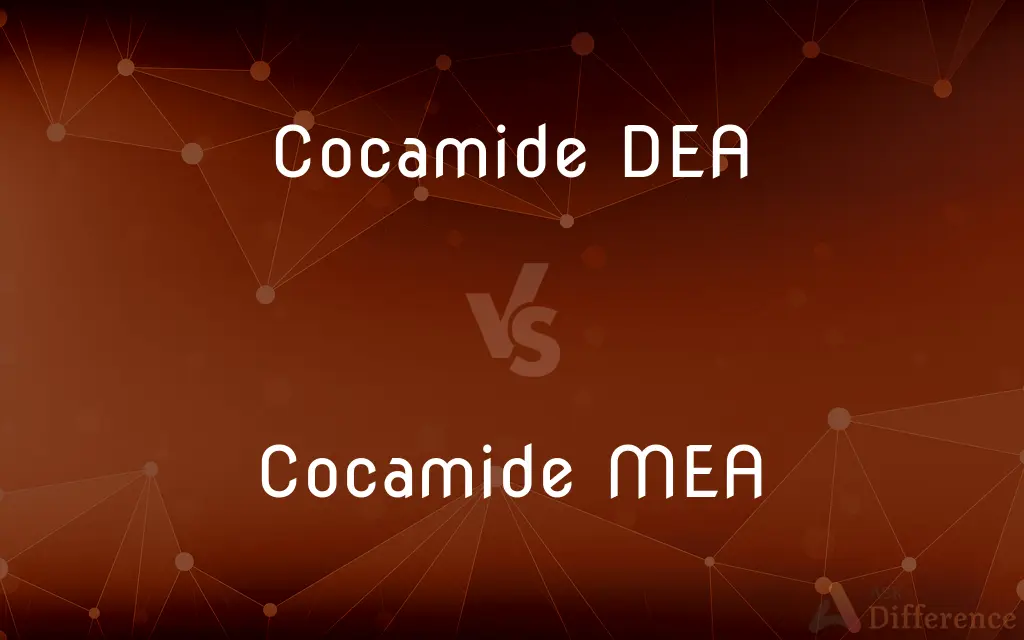Cocamide DEA vs. Cocamide MEA — What's the Difference?
By Tayyaba Rehman & Urooj Arif — Published on February 16, 2024
Cocamide DEA (Diethanolamine) and Cocamide MEA (Monoethanolamine) are both coconut oil-derived emulsifiers and foam boosters in cosmetics, differing mainly in their molecular structure and viscosity-enhancing properties.

Difference Between Cocamide DEA and Cocamide MEA
Table of Contents
ADVERTISEMENT
Key Differences
Cocamide DEA and Cocamide MEA are both derived from the fatty acids in coconut oil, but they are processed with different ethanolamines. Cocamide DEA is produced by reacting fatty acids with diethanolamine, resulting in a compound that acts as a viscous liquid in cosmetic formulations. It is known for its ability to create a rich lather and its thickening properties in products like shampoos and liquid soaps. Cocamide MEA, on the other hand, is the result of fatty acids reacted with monoethanolamine, leading to a somewhat milder surfactant with similar but slightly less intensive foam-boosting and viscosity-increasing effects.
The key difference between the two lies in their molecular makeup, which impacts their functionality in cosmetic formulations. Cocamide DEA tends to produce more foam and offers better thickening capabilities, making it a preferred choice for products requiring rich lather. Cocamide MEA, while still effective at increasing viscosity and enhancing foam, is often chosen for its milder nature, making it suitable for products aimed at sensitive skin.
Both compounds serve to stabilize foam and enhance the texture of personal care products, but the choice between Cocamide DEA and Cocamide MEA often depends on the specific requirements of the formulation and the desired end-user experience. Cocamide DEA's more pronounced thickening effect may be desired in shower gels and shampoos, whereas Cocamide MEA could be favored for its gentler formulation in products like baby shampoos or sensitive skin cleansers.
Regulatory considerations also play a role in the selection between Cocamide DEA and Cocamide MEA. Some regions have restrictions on the use of DEA compounds, including Cocamide DEA, due to health concerns. This has led formulators to prefer Cocamide MEA or seek alternative ingredients that meet safety guidelines while providing similar benefits.
In summary, while both Cocamide DEA and Cocamide MEA are used to achieve similar outcomes in personal care products, differences in their chemical structure, foam production, and regulatory status influence their application in the cosmetics industry.
ADVERTISEMENT
Comparison Chart
Molecular Structure
Contains two ethanolamine groups
Contains one ethanolamine group
Foaming Capability
Higher foaming capacity
Slightly lower foaming capacity
Viscosity Enhancement
Provides a greater increase in product viscosity
Offers a mild increase in viscosity
Application
Used in high-foaming and thickening products like shampoos
Preferred for milder formulations, suitable for sensitive skin
Regulatory Considerations
Subject to more stringent regulatory scrutiny due to health concerns
Generally considered milder, with fewer regulatory restrictions
Compare with Definitions
Cocamide DEA
Derived from coconut oil and diethanolamine.
We use cocamide DEA because it's derived from natural coconut oil.
Cocamide MEA
Cocamide MEA is a foam booster derived from coconut oil.
Our baby shampoo formula includes cocamide MEA for gentle cleansing.
Cocamide DEA
Enhances the texture and feel of cosmetic products.
The creamy texture of this lotion is due to cocamide DEA.
Cocamide MEA
Provides mild thickening to cosmetics and personal care products.
Cocamide MEA subtly increases the thickness of this facial cleanser.
Cocamide DEA
Acts as a thickening agent in personal care products.
Cocamide DEA was added to increase the viscosity of the liquid soap.
Cocamide MEA
A milder surfactant suitable for sensitive skin formulations.
For sensitive skin, we recommend products with cocamide MEA.
Cocamide DEA
Cocamide DEA is a viscous liquid used as a foaming agent in cosmetics.
This shampoo contains cocamide DEA for its superior lathering effect.
Cocamide MEA
Enhances foam quality with less irritation.
Cocamide MEA ensures a soft, luxurious foam in our newest body wash.
Cocamide DEA
Used to stabilize foams in cleansing products.
Cocamide DEA helps maintain the foam stability of our bath gels.
Cocamide MEA
Used in products aiming for a gentle touch and mild cleansing.
Cocamide MEA makes this shampoo gentle enough for daily use.
Common Curiosities
Can Cocamide DEA and Cocamide MEA be used interchangeably?
While they serve similar purposes, their differences in foaming and viscosity effects may affect the final product's texture and suitability for sensitive skin.
Which is better for sensitive skin products?
Cocamide MEA is generally considered better for sensitive skin due to its milder nature.
Are there health concerns associated with Cocamide DEA?
Cocamide DEA has faced regulatory scrutiny due to potential health concerns, leading some formulators to prefer Cocamide MEA.
Is Cocamide MEA environmentally friendly?
While derived from natural coconut oil, its environmental impact depends on the manufacturing process and biodegradability.
What are Cocamide DEA and Cocamide MEA?
Both are coconut oil-derived ingredients used in cosmetics for foaming and thickening.
How are Cocamide DEA and Cocamide MEA derived?
Both are synthesized from coconut oil but differ in the ethanolamine used in their production.
Why is Cocamide DEA used in shampoos?
Its high foaming capacity and thickening properties make it ideal for shampoos and similar products.
Do Cocamide DEA and Cocamide MEA affect hair and skin differently?
Their primary roles are as foaming and thickening agents, with Cocamide MEA being slightly milder, potentially making it more suitable for sensitive skin and scalp.
Can these ingredients cause allergies?
Like any cosmetic ingredient, there's a potential for allergies, though Cocamide MEA is typically seen as less irritating.
How do Cocamide DEA and Cocamide MEA differ in use?
Cocamide DEA is preferred for its foaming and thickening in robust formulas, whereas Cocamide MEA is favored for gentler, sensitive skin products.
How do I choose between Cocamide DEA and Cocamide MEA for my product?
Consider the product's intended use, desired foam level, and viscosity, along with any regulatory or sensitivity concerns.
Are Cocamide DEA and Cocamide MEA safe for daily use?
When used within recommended concentrations in properly formulated products, they are considered safe for daily use.
Can I find these ingredients in organic cosmetics?
They may appear in products labeled as organic, depending on the certification standards and other ingredients used.
How do these ingredients impact the environment?
The environmental impact largely depends on their source and the manufacturing process. Generally, the industry is moving towards more environmentally friendly practices.
Are there alternatives to Cocamide DEA and Cocamide MEA?
Yes, there are other foaming agents and thickeners available for formulators looking to meet specific product needs or address regulatory and safety concerns.
Share Your Discovery

Previous Comparison
Windows 7 vs. Windows VistaAuthor Spotlight
Written by
Tayyaba RehmanTayyaba Rehman is a distinguished writer, currently serving as a primary contributor to askdifference.com. As a researcher in semantics and etymology, Tayyaba's passion for the complexity of languages and their distinctions has found a perfect home on the platform. Tayyaba delves into the intricacies of language, distinguishing between commonly confused words and phrases, thereby providing clarity for readers worldwide.
Co-written by
Urooj ArifUrooj is a skilled content writer at Ask Difference, known for her exceptional ability to simplify complex topics into engaging and informative content. With a passion for research and a flair for clear, concise writing, she consistently delivers articles that resonate with our diverse audience.

















































